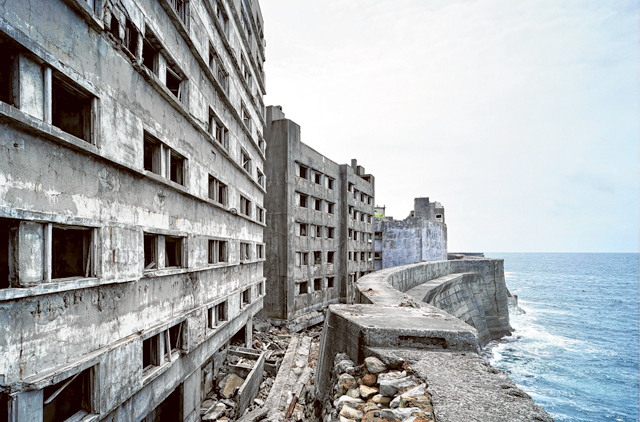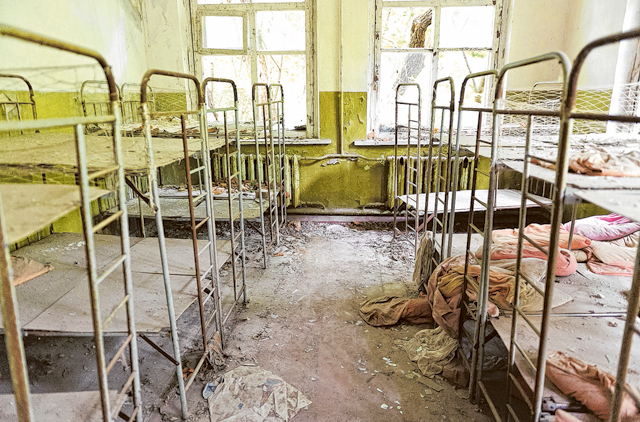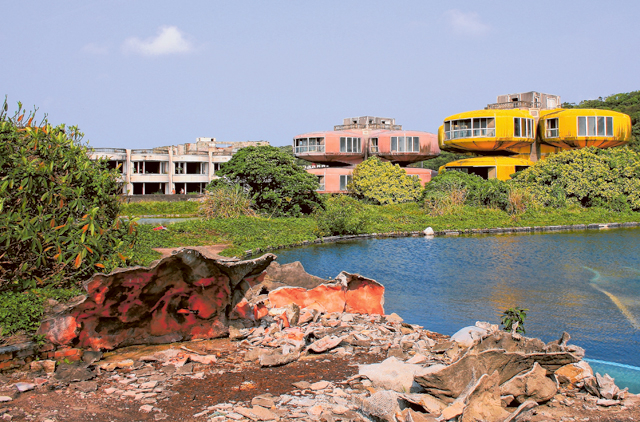
“Many times we would enter huge Art Deco buildings with once-beautiful chandeliers, ornate columns and extraordinary frescoes and everything was crumbling and covered in dust and the sense that you had entered a lost world was almost overwhelming.”
These are the words of the French photographer Yves Marchand who, with Romain Meffre, created one of the most talked-about photography books of recent times, “The Ruins of Detroit”, published in 2011. It portrayed the once-great American industrial city as a kind of lost world, where, as Marchand put it, “the magnificence of the past is everywhere evident”.
Their photographs of abandoned ballrooms, theatres, police stations and entire blocks of once-ornate Art Deco-style buildings struck a chord worldwide. When I interviewed them just after the book’s publication, the resulting feature and picture gallery became one of the most-viewed online stories on the Guardian website.
In terms of our collective fascination with abandoned places today, the publication of “The Ruins of Detroit” was a tipping point, the moment when a curiosity turned into an obsession, as a cursory Google search of “abandoned places” will attest. It has grown into an online subculture, where newly discovered abandoned places are constantly photographed and the results shared via websites, Facebook, Instagram and Twitter.
The titles of the websites give some indication of the content as well as the lure of the old, crumbling and derelict: Abandoned Places, Deserted Places, The Most Haunting Abandoned Places on Earth, 31 Haunting Images of Abandoned Places That Will Give You Goose Bumps. Among the celebrities who have been given goosebumps and tweeted about it are Kendrick Lamar (“breathtaking”), Jared Leto (“bizarrely beautiful”), Jeremy Vine (“ace”) and Bianca Jagger (“fascinating”), while writers such as Margaret Atwood and Anne Rice have also expressed their fascination with empty buildings.
Initially, it is not hard to see why many of the images on these sites exert such a hold on the collective imagination. As the adjectives most often used to describe them — nostalgic, romantic, haunting — suggest, there is something paradoxically beautiful, not to say seductive, about decaying buildings, particularly ones that were once baroquely magnificent.
Many of the ruined mansions exert the same sort of fascination as certain passages from Victorian or Gothic literature — Dickens’s evocation of Miss Havisham’s crumbling house in “Great Expectations”, Mervyn Peake’s descriptions of the labyrinthine halls and corridors of Gormenghast castle — while suggesting the decline and fall of great families or dynasties.
Then there are the images of cities or entire landscapes that have been deserted and left desolate, whether swaths of downtown Detroit or the modern ghost towns that border Chernobyl following the nuclear accident of 1986. In the former, the broader arc of history and commerce is suggested, not just in the decline of a great city, but possibly of a country, an empire. In the latter, our fear of nuclear disaster, and its apocalyptic aftermath, is summoned. Here, too, the precedents are fictional, but they tend to be darker, from the metaphysical chill of T.S. Eliot’s epic poem “The Waste Land” to post-apocalyptic sci-fi novels, most notably the dystopian and oddly prescient stories of J.G. Ballard or, more recently, Cormac McCarthy’s unremittingly bleak survival novel, “The Road”.
And, just as certain descriptive passages in Ballard’s 1962 novel, “The Drowned World” — about a flooded future London — seemed to prefigure the fate of New Orleans after the levees broke in 2005, so, too, do many of these photographs presage our own increasingly real fears about global economic meltdown and the increasing ecological fragility of a planet that we have ravaged relentlessly for its natural resources. If this kind of desolation can happen to a major American city, the images in “The Ruins of Detroit” say, surely it can happen anywhere.
What is revealing, too, while trawling through these images online, is the distinctly postmodern sense that often you are looking at a world that is more familiar from film than real life. The abandoned submarine base in Balaklava, Ukraine, is straight out of Andrei Tarkovsky’s “Stalker”, while the eerily empty and vast subway tunnel in Kiev, Ukraine, could be part of the set for any number of science-fiction films, from the “Star Trek” series to “Alien”. Likewise, the Mirny diamond mine in eastern Siberia, a vast landscape of dust-coloured, low-lying buildings arranged around an ominously gaping hole in the Earth’s surface. The Russians, it seems, do post-apocalyptic sci-fi landscapes better than anyone else.
Elsewhere, though, the photographs of desolate urban landscapes speak of more real than imagined fates. The crumbling interiors of once-bustling civic buildings — hospitals, prisons, police stations, libraries, banks — are signifiers, if more were needed, of the indiscriminate thrust of global capitalism. More melancholy still are the ruins of our once-stately pleasure domes and dream palaces: cinemas, theatres and dancehalls figure largely, as do funfairs, their giant wheels and snaking rollercoasters now silent and still as weeds and tall grasses sprout around their stalls.
Somewhere in Japan, the wind whistles though a vast bowling alley where the balls sit motionless, casting long shadows across a floor cluttered with debris. In the shadow of Mount Fuji, a giant Gulliver, built in 1997, lies forever tethered to the ground in a disused theme park, his skin and clothes fading in the elements to the muted colours of the surrounding landscape.
As our fascination grows, it has spawned a network of amateur photographers who locate, shoot, then disseminate their images, many of which are beautifully lit, artfully composed and possibly Photoshopped. They are, in fact, a camera-club version of the high-end art-documentary style of photographers such as Marchand and Meffre, or Robert Polidori, whose images of post-hurricane Katrina New Orleans are powerful, disturbing and somewhat unsettling in their artful beauty.
Polidori was dubbed “a connoisseur of chaos” by the New York Times’s always astute art critic, Michael Kimmelman, who also noted how “the beauty of his pictures — they have a languid, almost underwater beauty — entails locating order in bedlam”.
His unforgettable images of a ruined New Orleans are devoid of people, but they home in, instead, on the often-surreal wreckage — houses moved across streets by the tidal surge, interiors that seem suddenly old and decayed as a result of flood damage.
Kimmelman concedes that “it is only human to feel uneasy about admiring pictures like these whose sumptuousness can be disorienting”, which gets close to the heart of paradox of these images. The late John Updike, in a review of Polidori’s book, “After the Flood”, was more perplexed. “‘After the Flood’ is an opulent volume, brilliantly sharp in its large, 10in by 14in [25 by 36 centimetres] reproductions, bound in lavender cloth, and difficult to manipulate anywhere but on a coffee table. It weighs nearly 10lbs [4.5 kilograms] and costs $90 (Dh330); a consumeristic paradox hovers over the existence of so costly a volume portraying the reduction of a mostly poor urban area to a state of desertion and deeper destitution. Who is this book for?”
Though the contemplation of ruins is a long tradition in art and architecture, for some critics, these contemporary images are simply “ruin porn”: an aestheticising of urban decay that elevates the beauty of the bleak over the complex socioeconomic reasons for such dramatic urban decline. In his fascinating social history, “The Last Days of Detroit”, local writer Mark Binelli touched on this seductive nature of once-grand and now-derelict buildings. “For all the local complaints about ruin porn, outsiders were not alone in their fascination. Among my friends and acquaintances, Phil staged secret, multi-course gourmet meals in abandoned buildings John and his buddies played ice hockey on the frozen floors of decrepit factories Travis was hired to shoot suburban wedding photographs in the ruins of the old Packard plant.”
Herein perhaps lies something of the true nature of our fascination with abandoned places: they allow us to look at, even surround ourselves with, the traces of decay and desolation, without actually experiencing the human cost. That there are no people in these photographs is, of course, part of their haunting power, their melancholic force. For the photographers, this is an aesthetic call. As Updike noted, Polidori “loves the grave, delicate and poignant beauty of architecture when the distracting presence of human inhabitants is eliminated from photographs”. Like Marchand and Meffre, he is working in a documentary landscape tradition, but one that grows ever more formal and detached.
Marchand and Meffre have since gone on to document the abandoned island city of Hashima in a book called “Gunkanjima”. Only 40 years ago Hashima, which was nicknamed Gunkanjima or Battleship for its shape like a ship, was the most densely populated place in the world. Five thousand people lived in the labyrinthine streets of the tiny island, many working in the coal mine whose excavated slag formed the foundations of a densely packed town that grew upwards. In 1974, the mine closed and, within six months, the last resident returned to the mainland, leaving behind a warren of deserted shops, including a barber, a bank, a bathhouse, schools, a shrine and several shops and restaurants.
Hashima is a ghostly place, made all the more so when you see the old photographs taken when it was inhabited that punctuate their book. A local photographer shot the bustling, overcrowded community in which he lived and worked. It is the ghostly presence of these people that stalk the abandoned streets, shops and houses of Hashima as photographed by Marchand and Meffre.
And it is their life stories, in glimpsed traces — an old TV set, a rusting child’s bicycle — that haunt the images of this now empty place. We seem increasingly fascinated by what is left behind — ruins, objects, crumbling façades, empty shells; the beautifully decayed surface of things. But it is the people that left who are the real context for these photographs. Without that human context, they are just bleakly and romantically beautiful, visually seductive but empty of real meaning.
–Guardian News & Media Ltd















